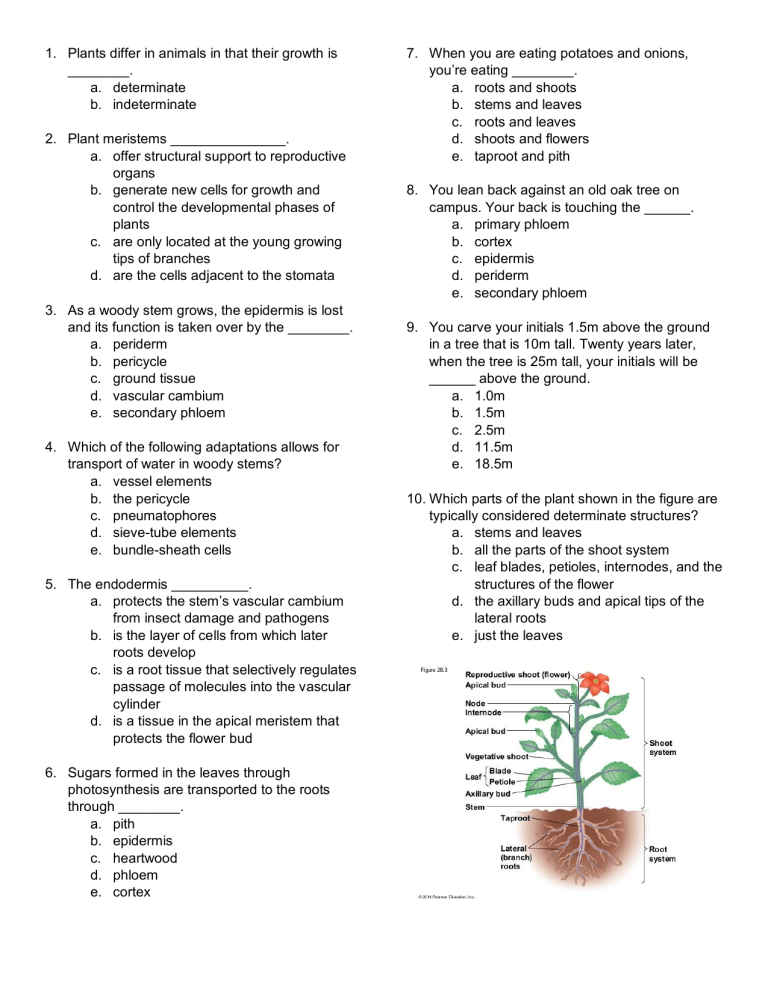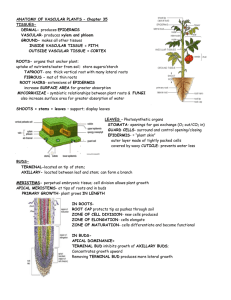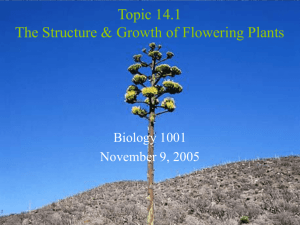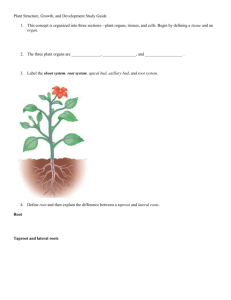
1. Plants differ in animals in that their growth is ________. a. determinate b. indeterminate 2. Plant meristems _______________. a. offer structural support to reproductive organs b. generate new cells for growth and control the developmental phases of plants c. are only located at the young growing tips of branches d. are the cells adjacent to the stomata 3. As a woody stem grows, the epidermis is lost and its function is taken over by the ________. a. periderm b. pericycle c. ground tissue d. vascular cambium e. secondary phloem 4. Which of the following adaptations allows for transport of water in woody stems? a. vessel elements b. the pericycle c. pneumatophores d. sieve-tube elements e. bundle-sheath cells 5. The endodermis __________. a. protects the stem’s vascular cambium from insect damage and pathogens b. is the layer of cells from which later roots develop c. is a root tissue that selectively regulates passage of molecules into the vascular cylinder d. is a tissue in the apical meristem that protects the flower bud 6. Sugars formed in the leaves through photosynthesis are transported to the roots through ________. a. pith b. epidermis c. heartwood d. phloem e. cortex 7. When you are eating potatoes and onions, you’re eating ________. a. roots and shoots b. stems and leaves c. roots and leaves d. shoots and flowers e. taproot and pith 8. You lean back against an old oak tree on campus. Your back is touching the ______. a. primary phloem b. cortex c. epidermis d. periderm e. secondary phloem 9. You carve your initials 1.5m above the ground in a tree that is 10m tall. Twenty years later, when the tree is 25m tall, your initials will be ______ above the ground. a. 1.0m b. 1.5m c. 2.5m d. 11.5m e. 18.5m 10. Which parts of the plant shown in the figure are typically considered determinate structures? a. stems and leaves b. all the parts of the shoot system c. leaf blades, petioles, internodes, and the structures of the flower d. the axillary buds and apical tips of the lateral roots e. just the leaves 11. In what order would the following structures be encountered when moving from the outside to the center of a typical eudicot stem? a. epidermal cell, pith, sieve-tube elements, sclerenchyma cells, pith, xylem tissue b. epidermal cell, mesophyll, vascular bundle, pith c. epidermal cell, cortex, endodermal cell, pericycle, stele, pith d. epidermal cell, parenchyma cells, fiber cells, sieve-tube elements, vessel members, parenchyma cells e. epidermal cell, cortex, vascular tissue, pith 12. You are studying a plant that is tall, with lots of leaf area to catch wind. Which of the following do you expect it to have? a. prop roots b. stolons c. petioles d. reproductive leaves e. extra mesophyll 16. Imagine that you are eating a fruit that is new to you, and you notice the tough texture of the flesh. Which of the following does the flesh likely have a large amount of? a. root hairs b. stomates c. sclereids d. layers of cuticle e. cambiums 17. The root ______________ is where it generate cells in root growing axis. 18. These are relatively undifferentiated and thinwalled cells that retain the ability to divide and perform most of the metabolic functions of synthesis and storage. a. Collenchyma b. tracheids c. Vessel elements d. Parenchyma e. Schlerenchyma 13. Which tissue system is the greatest obstacle to the entry of pathogens into a plant? a. dermal b. vascular c. ground d. b and c equally 19. A highly specialized epidermal cells found in shoots consists of outgrowth to reduce water loss and reflects light. a. Periderm b. Cuticle c. Trichomes d. Guard Cells e. Stomata 14. Which meristem is most important for the wooden door of your classroom? a. root apical meristem b. vascular cambium c. cork cambium d. shoot apical meristem e. none of the above 20. Ground tissue that is internal to the vascular tissue a. Cortex b. Periderm c. Stele d. Pericycle e. Pith 15. The removal of which of the following would harm photosynthesis the most? a. root hairs b. cuticle c. mesophyll d. phloem Give at least 2 modified adaptations of stems 21. ______________________ 22. ______________________ Give at least 2 adaptations of modified roots 23. ______________________ 24. ______________________ Give at least 1 modified adaptations of leaves 25. ______________________ 1. b 2. b 3. a 4. a 5. c 6. d 7. b 8. d 9. b 10. c 11. d 12. a 13. a 14. b 15. c 16. c 17. apical meristem 18. d 19. c 20. e 21.-22. rhizomes, stolons, tubers 23.-24. buttress roots, prop roots, storage roots, pnuematophores, “strangling” areal roots 25. tendrils, spines, storage leaves, reproductive leaves





